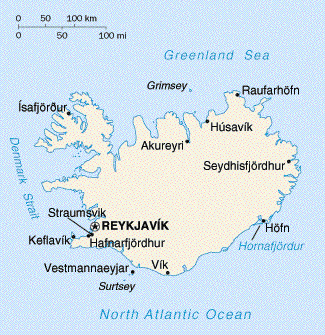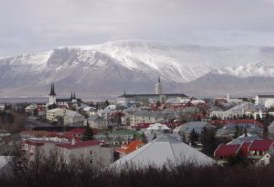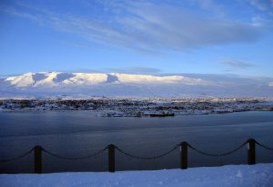Iceland
Travel The World

Background
It's an island in the North Atlantic Ocean. It's considered the western most country of Europe. Iceland lies south of the arctic circle,
north-west of Scotland and west of Norway. Iceland is a republic.
Iceland is one of Europe’s most sparsely populated nations and the last country to be inhabited. The culture, language and people are
mostly influenced by the Scandinavian countries with a combination of Celtic appearances. I was prepared for a relatively small town feel
during our stay at Reykjavik and mostly countryside tourism and hiking, but was extremely taken aback to find how isolated, barren, unique,
exotic and how extremely beautiful this place actually is! Iceland’s attraction is its untamed countryside. Considering that most
of this rugged island is uninhabitable, this leaves much open space and fresh air to the brave adventurer for exploring. Iceland stretches
about 540 km east to west. Norwegians were the first to settle it, in the 9th and 10th centuries, beginning in 874.
It claims many firsts and oldest. Icelandic is the oldest continuously existing language in Europe and has changed little
since the days of the sagas, except in its pronunciation.
[ Religions: Lutheran Church of Iceland, Reykjavik Free Church, Roman Catholic Church, Hafnarfjorour Free Church,..]
[Administrative divisions: 8 regions; Austurland, Hofudhborgarsvaedhi, Nordhurland Eystra, Nordhurland Vestra, Sudhurland, Sudhurnes, Vestfirdhir, Vesturland ]
It claims many firsts and oldest. Icelandic is the oldest continuously existing language in Europe and has changed little since
the days of the sagas, except in its pronunciation.
Life expectancy in Iceland is high, unemployment is low and the country has a literacy rate of close to 100%, the highest in the world. Reykjavik, the capital, with a
population of around 175,000, in a national population of a bit over 285,000, has an astonis-hing variety of cultural offerings: seven libraries, eight historical museums,
nine art museums, nine theatres and more than 30 professional drama groups.
The island's largest cities:
Reykjavik, the capital
Akureyri
Kopavogur
Hafnarfjordur
Keflavik
Nationality:
Icelander/s


Language:
Icelandic
English,
Nordic languages
German widely spoken


Images: Reykjavik
VATNAJÖKULL, AN ICE CAP. Dominating the southern half of the island is Vatnajökull, an ice cap that is bigger than all the glaciers of
Europe put together. It dates back 2000 years, covers 8,400 sq. km, is 400 metres thick and holds 200 volcanoes.
In the coastal town of Hafnarfjördur – a place that is more fun to visit than to pronounce – you find the smallest mountain in Iceland.
The town hosts an international Viking festival and offers guided tours of what is, according to the local seer, the
country’s largest community of elves.
ICELAND’S LARGEST FOREST. Near the town of Egilsstadir on the east coast is Iceland’s largest forest. It is about the
size of a country park in Britain or mainland Europe and reflects the great paucity of trees on the island. Forests occupy only
1% of the land in Iceland and in a reforestation programme run by the government in the 1960s and 1970s, Icelanders were
given seeds to thrown out of their cars as they drove around the country. Another 1% of the land is arable. Icelanders’ main occupations as
fishing, cultivation in greenhouses warmed by water from natural springs and, latterly, tourism.
THE ARCTIC CIRCLE clips the north of Iceland and the island is warmed, like Britain, by the Gulf Stream. The island therefore enjoys warmer
temperatures than mainland Europe of the same latitude, while also basking in 18 or more hours of daylight at
the height of summer. The other side of that coin is the long period of darkness that shrouds every day in winter. Iceland’s
national park at Skaftafell, a warm and balmy 11 degrees C in July and merely freezing in January, is well vegetated
with shrub, some trees and wild flowers and rises to a mountain top at 710 metres.
THE BLUE LAGOON, a thermally heated open-air lake, where in winter you can bask in the water and be snowed on at the
same time, was created by accident. Condensed water from a nearby power plant was pumped away and expected to disappear, but instead
the minerals it contained made the lava watertight. These minerals, along with silica and algae, give the
lagoon its blue colour. Here you can give yourself a natural face mask by scooping out some white mineral paste from a bucket
at the side of the lagoon and slapping it on your face. White-faced figures shrouded in steam from the warm water and the
moonsurface rocks that surround the pool give the place a surreal atmosphere.
ICELAND IS A PARADISE FOR BIRD LOVERS. As well as the eider duck, skua, kittiwake, Arctic tern and many kinds of gull, there is the
delightful puffin, which, if you are lucky, will come and sit beside you on a cliff. Most puffins are born in Iceland.
They learn to fly the hard way when their parents literally toss them out of the nests, and, after a little practice, can reach a top
speed of 80 km/h. They migrate to and from Newfoundland, Norway, Ireland and Britain. Puffins mature at five years and can
live to nearly 30, although some end up on restaurant menus before their allotted lifespan is over. Icelanders are fond of their puffins and may
band together to help ‘lost’ birds get back to the shores or the hillsides where they belong.
VOLCANIC ERUPTIONS. In 1783 there was an enormous volcanic eruption, which created a lava field extending over 565 sq.
km and measuring 12 cu. km in volume. So damaging was the event that the population fell from 50,000 to 38,000.
The lava field, now covering stretching out along and around the main road round the south of Iceland, is the largest ever formed
in a single eruption in recent times.
Another catastrophic event was the glacial burst that occurred in November 1996, when a volcanic eruption beneath Vatnajökull caused a massive
outflow of lava spilling out over the ice and all the way down to the sea, about 25 km away, taking with it
bridges and parts of the road.
FIRE GORGE. A spectacular part of southern Iceland is the 40-km long Fire Gorge, reachable only by four-wheel-drive vehicles that can ford rivers
and negotiate rough ground. Red rock, green moss and stunning waterfalls characterise this remote valley.
You pass by the Fire Gorge on the way to Landmannalaugur, a place of extraordinary beauty and untouched in a way unimaginable in even
the furthest reaches of the British Isles. Here rhyolite, a volcanic rock, assumes all the colours of the
rainbow – even blue – and the barren, multi-hued rolling hills rise above flat plains, thermal pools, fields of jagged, porous lava
and thermal vents, gently smoking and reeking of sulphur. Each year an Ultramarathon is held around Landmannalaugur, comprising stages
of 10 km, 11 km, 16 km and 13.5 km. There is also a conventional marathon held in Reykjavik in August.
Kirkjubaerklaustur – which translates roughly as ‘church farm cloister’ – sits on a river near the sea and it was here that the
great lava flow of 1783 came to an abrupt halt, because, the residents believed, they had prayed for salvation in the small church at that site.
The end of the lava can still be clearly seen near the village. A little way along the river is Sisters Rock, where, the story goes, two nuns were
buried after being burnt at the stake for breaking their vows. One was said to have consecrated Communion bread at the door of a privy and to
have had carnal knowledge of men. The other had spoken blasphemously of the Pope. After the Reformation, the first nun was proclaimed innocent
and beautiful flowers grew on her grave; the second nun’s grave remained barren.